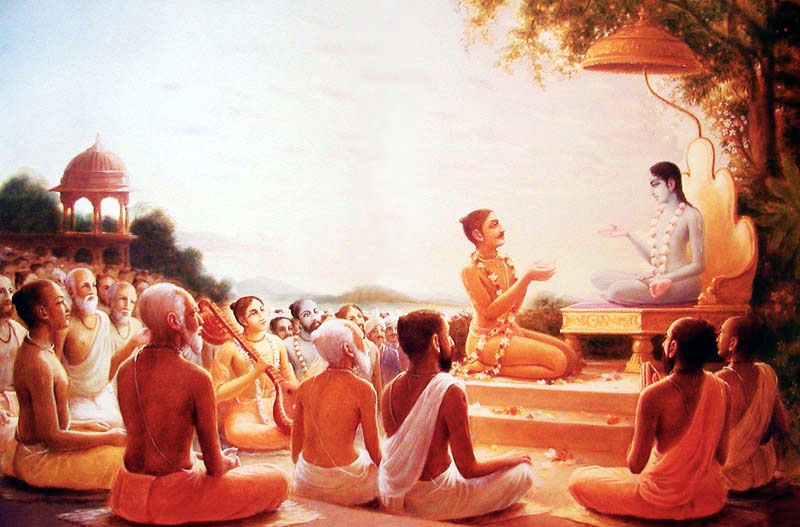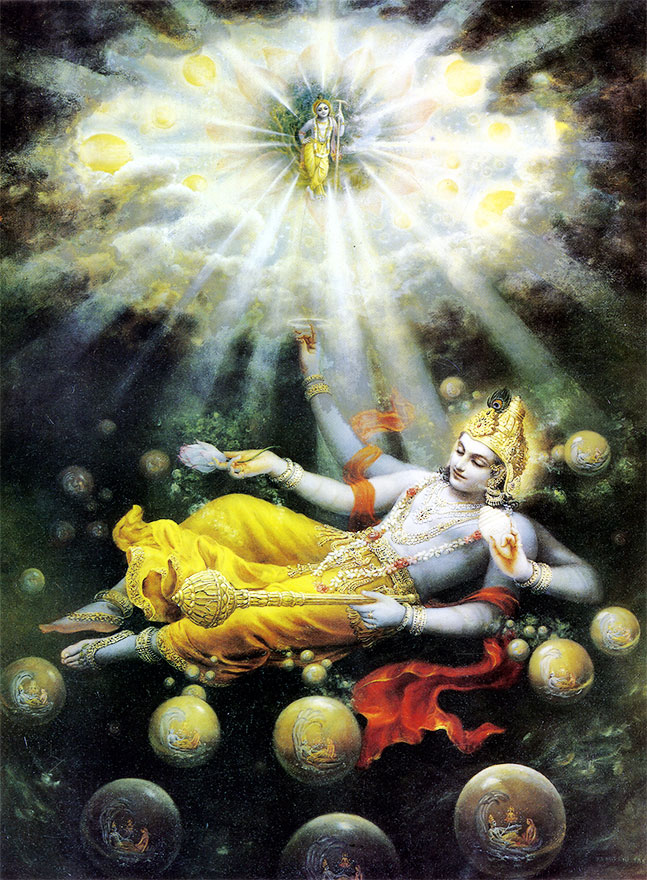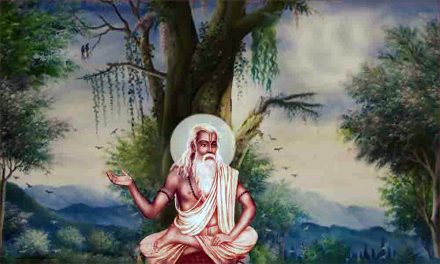Īśāvāsya (ईशावास्य) is the only one among the Principal Upaniṣads which is part of a Samhita. It is the end part of Śukḻa Yajurveda (Kāṇva recension), consisting of 18 verses in poetry. Being part of a Samhita is a testimony for the authenticity and ancientness of the Upaniṣad. While taking up the study of this very small Upaniṣad, we confine our analytical endeavour to the limits that we have already set, in the case of our previous studies.
This Upaniṣad derives its name from the opening word of its first verse. Īśāvāsya means abode of the Ruler; Īśa is Ruler and āvāsya is abode. The Upaniṣad describes who this Ruler is and how man should yearn to attain to the ultimate principle of this Ruler.
[wp_ad_camp_1]
Let us now look at the first verse. It reads thus:
ईशावास्यमिदं सर्वं यत् किंच जगत्यां जगत्
तेन त्यक्तेन भुञ्जीथा मा गृधः कस्यस्विद् धनम् || 1 ||
īśāvāsyamidaṃ sarvaṃ yat kiṃca jagatyāṃ jagat
tena tyaktena bhuñjīthā mā gṛdhaḥ kasyasvid dhanam (1)
Meaning: ‘All that is here in this ever-changing world constitutes the abode of the Ruler (He is the in-dweller in everything); therefore, when you take anything here to utilize for your benefit, do it with a sense of renunciation (rather than arrogation); you should not covet others’ means of living (dhana is prey, the thing on which one feeds on)’.
In other words, the world is subject to continuous change; it has a Ruler. The whole world is his abode; that is, He occupies everything here. Nobody has, therefore, any possession right over anything here, but only enjoyment right. So, don’t attempt to arrogate anything to yourself. Further, when you take something for your enjoyment, renunciation must be the guiding principle.
How should we understand these instructions? First of all, please take notice of the mention about ever-changing nature of the world. The westerners believe that it was the Greek philosopher Heraclitus who said for the first time about the world’s ever changing nature. 5th century BC was his life-time. But the declaration in this Upaniṣad must be about 1000 years prior to that, since this is part of Yajur Veda Samhita which belongs to that age.
Then, who is the Ruler mentioned here? The verse itself says that this Ruler is the in-dweller of everything. That is, everything is pervaded by him. We have already understood from our previous studies that the entity pervading everything is nothing but Ātmā which is the ultimate principle ‘SAT-CHIT-ĀNANDA’. It is declared in section 3.7 of Bṛhadāraṇyaka Upaniṣad that Ātmā is the inner controller of all beings. Being the sole controller, he is called here as the Ruler; he is one without a second. Since he pervades and controls everything, the entire universe is said to be his body (vide 3.7.1 to 3.7.23 of Bṛhadāraṇyaka). With him remains vested all rights over his body, proprietary as well as possessionary. The physical bodies of all beings are only constituents of this universal body; as the Ruler of the whole, he is to see that all these constituents remain in their appropriate places and that they maintain an inter-connection promoting the sustenance of the whole. It is also essential that each constituent should have access to such of other constituents as are necessary for its survival. Therefore, if any particular constituent acquires everything that fancies him and keep the same under his possession and disposal, over and above its actual sustenance needs, it would spell break-down of the system, as some other constituents will be deprived of the essential resources for its survival. That is why this caution of renunciation: ‘enjoy, but don’t take away anything to own exclusive possession’ (tena tyaktena bhuñjīthā, mā gṛdhaḥ kasyasvid dhanam). It is worthwhile to state here that no socialist or other ethical ideas on welfare of the mankind can ever match this declaration in profundity of wisdom and logic.
All that we have seen advocates a reduced inclination to the pursuit of physical pleasures. It is only when we are increasingly prone to physical pleasures that we start to disregard the needs of others and get entangled in all corrupt and wicked practices which spell ruin for the whole system as well as for ourselves.
When we speak of renunciation, a question would naturally arise, “What should we renounce?” We should have something of our own to renounce; but, as clarified above, we have no true ownership or possession right on anything in this world. This dilemma is solved by the next verse which provides the precise answer; Karma (deed or action) is the answer. Our Karma is our own prerogative (karmaṇi eva adhikāraḥ te – कर्मणि एव अधिकारः ते – Gīta 2.47); it is our existential essentiality (Muṇḍaka Upaniṣad 1.1.8). Verse 2 insists that one should live by doing Karma; renouncing Karma is not by refraining from doing it, but by submitting the results thereof to the service of the whole. Such performance of Karma does not cause any bondage to the performer (न कर्म लिप्यते नरे – na karma lipyate nare). The verse points out that those who lived a full life in the past did so by doing Karma in this manner. Therefore, the instruction is to follow the same path. The most important thing to be taken in from this verse is that it asserts the compulsory performance of Karma; withdrawal from performing the Karma is not considered a virtue that would absolve us of bondage. What wards off bondage is the renunciation of the results of Karma; so one is not justified in giving up performance of Karma for the sake of detachment (mā saṅgaḥ astu akarmaṇi – मा सङ्गः अस्तु अकर्मणि – Gīta 2.47; see also Gīta 3.4, 3.9, etc). It was this idea, cumulatively occurring in verses 1 & 2, which the communists later re-discovered, after about 3000 years, in their declaration, “From each according to his ability, to each according to his need”.
Having thus laid down necessary instructions for proper living, in conformity with the ultimate principle of Ātmā, the Upaniṣad warns against negation of that principle, in verse 3. Those who defy Ātmā and pursue the ways of selfishness are cast into the worlds of utter darkness wherein the sun of enlightenment never rises; he gets more and more entangled in the whirlpools of worldly life and thus becomes ruined (Wisdom will never dawn on those who are carried away by indulgence in sensual pleasures and affluence – Gīta 2.44).
In continuation of this warning against disregard of the principle of Ātmā, the Upaniṣad presents a description about the nature of Ātmā in verses 4 to 8. Verse 4 says that Ātmā is unmoving and the only one entity; it is faster than the mind and ungraspable by the senses; unmoving, it transcends all that is moving and it is only upon Ātmā that Prāṇa projects all actions (of living beings). Ātmā is unmoving because it pervades everywhere and therefore no space to move into. It is only one, since everything is its manifestation and is pervaded by itself. Being not physical, it is not grasped by the senses and being the energy (consciousness) motivating the mind, it must be faster than the mind. Since every moving object is involved in Ātmā, it is said to transcend all; all actions occur as effects of consciousness part of Ātmā, aided by Prāṇa and therefore it is said that all actions are projected by Prāṇa upon it.
It is further explained in verse 5 that Ātmā pervades all. Verses 6 and 7 speak about how the world is viewed by a person, who sees unity in all beings such that all beings are perceived in himself and also himself in all beings; he cannot hate or reject any being and he cannot have either passion or grief.
Now, we come to the most important verse of Īśāvāsya, the verse 8, which describes the features of Ātmā thus:
स पर्यगात् शुक्रं अकायं अव्रणं अस्नाविरं शुद्धं अपापविद्धम्
कविः मनीषी परिभूः स्वयम्भूः याथातथ्यतोर्थान् व्यदथात् शाश्वतीभ्यः समाभ्यः || 8 ||
sa paryagāt śukraṃ akāyaṃ avraṇaṃ asnāviraṃ śuddhaṃ apāpaviddham
kaviḥ manīṣī paribhūḥ svayambhūḥ yāthātathyatorthān vyadathāt śāśvatībhyaḥ samābhyaḥ (8)
Meaning: ‘He pervades all; he is resplendent, bodiless, uninterrupted, without sinews, pure and devoid of evil; he is far-sighted, omniscient, transcendent and self-existing; it is he who ever sustains all realistic objects’.
This is self-explanatory.
In the next six verses, it is asserted that, together with pursuit of knowledge, Karma also is important in attaining immortality. We cannot choose anyone between these two, for the purpose. Those who exclusively pursue any one of these two will only fall into utter darkness. Through the practice of performing Karma, one should overcome Mṛtyu (Death) (mṛtyu is simply the surrender to temptations of Kāma) and through acquiring knowledge aspire to attain immortality (verses 9 to 14). These two, namely, performing Karma and acquiring knowledge go together, not one after another. Mechanical performance of Karma will not yield the required result; in order to draw lessons from experience, we should have sufficient knowledge also. The importance of performance of Karma lies in its serving as a practical exercise for establishing in the mind what is learnt in theory.
Further, immortality is verily the freedom from being felled by Kāma while Death is the state of being felled by Kāma. Gīta describes in 2.62 and 2.63 how a person faces death by submitting himself to Kāma; Bṛhadāraṇyaka says in 1.2.1 that hunger is death; hunger is the urge for devouring the desired things, which is Kāma only. The ignorant and the weak easily fall prey to the prowling Kāma, continuously. Sage Patañjali says in Yogasūtra 1.4 that we are what our state of mind disposes (वृत्तिसारूप्य – vṛttisārūpya). So, when Kāma overtakes us, we lose our true identity, and meet with death; such deaths occur frequently, many times even in a single day, for an unstable mind. After one death, there is a rebirth into an unenlightened form which again faces death and this chain of deaths continues for ever until we get enlightenment and become relieved of further death; this relief from death is called immortality. The deaths and rebirths evidently occur to the same physical person, not to different bodies; this is because when the body is lost, personal identity is lost for ever as we have already seen in Chāndogya (6.9.1 etc) and Bṛhadāraṇyaka (2.4.12, etc.).
The last four verses (15 to 18) of the Upaniṣad present an instance of an aspirant seeking to know and attain to the eternal truth. In verse 15, the seeker finds that the eternal truth is veiled by a golden plate and therefore, as an aspirant for enlightenment he seeks its removal, for which he makes an appeal to Pūṣan, who is responsible for its deployment. See the verse below:
हिरण्मयेन पात्रेण सत्यस्यापिहितं मुखम्
तत्त्वं पूषन् अपावृणु सत्यधर्माय दृष्टये || 15 ||
hiraṇmayena pātreṇa satyasyāpihitaṃ mukham
tattvaṃ pūṣan apāvṛṇu satyadharmāya dṛṣṭaye (15)
Satyadharma mentioned here means ‘eternal truth’. What is this golden plate and why is it an obstruction to knowing the eternal truth? The golden vessel is the ever-enticing sensual pleasures provided by physical entities. Gold symbolises that enticement. If we are carried away by this enticement, we would never be able to pursue the path of liberation. Pūṣan is the nourisher, the nourisher of physical endowments; obviously, he is responsible for the deployment of physical features that cause the said enticement. That is why the prayer for removal of enticement is directed to him; the prayer is to the effect that Pūṣan may make the endowments less attractive. This is just like removing the pricked thorn by another thorn.
The appeal in verse 15 is followed up in verse 16. The Pūṣan is entreated to employ the whole range of his reins (व्यूह रश्मिन् समूह – vyūha raśmin samūha) to contain the enticing features of this physical world supported by him, so that the aspirant may sight the real glorious Puruṣa within, who is nothing other than what he (the aspirant) really is. The implication is that the same principle (Puruṣa) pervades in all and he is attained on getting detached from the worldly entanglements of pleasure-pain and such other dual experiences.
Further, it is stated in verse 17 that the body will finally turn to ashes, while Prāṇa, which sustains life, is eternal (as it represents the ultimate principle of existence). Therefore, it is prayed that the thoughts about desires be extinguished.
(क्रतो स्मर कृतम् स्मर – krato smara kṛtam smara
kratu – desire; smara – memory, thought; kṛtam- done, extinguished).
Having thus laid down two paths (one of sensual pleasures and the other of enlightenment) to choose between, the Upaniṣad concludes the instructions with a prayer in verse 18 for being led in the right path. The prayer is directed to Agni, the omniscient Lord of all, for destruction of all deceiving evils. Agni is the symbol of knowledge and, therefore, the prayer directed to him implies seeking of enlightenment for distinguishing what is wrong and what is right. Please see the verse below:
अग्ने नय सुपथा राये अस्मान् विश्वानि देव वयुनानि विद्वान्
युयोध्यस्मज्जुहुराणमेनो भूयिष्ठां ते नम उक्तिम् विधेम || 18 ||
agne naya supathā rāye asmān viśvāni deva vayunāni vidvān
yuyodhyasmajjuhurāṇameno bhūyiṣṭhāṃ te nama uktim vidhema (18)
supathā rāye – supremely virtuous course; supatha – virtuous course, rāya – king, prince; vayunāni vidvān – having all knowledge.
Let us also pray for being led in the right path leading to enlightenment.
Readers can contact the author by email at: karthiksreedhar@gmail.com
Prior articles in this series:
The Science of the Upanishads – Introduction
The Science of Brihadaranyaka Upanishad
The Science of Chandogya Upanishad
The Science of Ishavasya Upanishad
The Science of Katha Upanishad
The Science of Kena Upanishad
The Science of Mandukya Upanishad
The Science of Mundaka Upanishad
The Science of Prashna Upanishad
The Science of Taittiriya Upanishad
The Science of Aitareya Upanishad
The Science of Shvetashvatara Upanishad
The Science of Upanishads – Conclusion















Very good explanation of the Upanishad. Thanks for publishing such articles and thanks to the author
Thanks for the opportunity to be in the group.
Ishavasya upanishad is explained in great detail and clarity. My sincere thanks for making available the article to the author and “Indiadivine.org”
Superb gist of the shri isha upanisad !The fluidity of the explanations very laudable.
This small Upanishad is one of the 10 Important Upanishads. Grateful for the lucid explanation.
I am blessed to be accepted in the group.I am a novice.I will yry to.grasp the inner meaning of the upamishds nby following the lucid commentary .
Upnishad should be taught with deep concentration, for following path of life, in school, college, every discourse.
great contribution,
Amazing and in shock and this is exactly what I have been searching for and found some insight. Every Tuesdy when I light the Ghee Lamp with Lime for the DEVI ,I watch the flame till the end . The energy and the glow of light from that flame brings be so much innerpeace to my heart and soul. I am still at the infant stage of learning. Namasthe.
very good
Your commentary is very excellent, however, it seems to mention only Atma, and not Paramatma as well. The “Ruler” is also not named, though there are beautiful pictures of Mahavishnu included in your text. And the Speaker of the Gita, Lord Krishna, is also not mentioned. I think your article would be even better if such important points were included. Swami Bhaktivedanta has done a beautiful exposition on the Ishapanishad that is quite amazing! Thank you for your brilliance, I hope you will write even more articles and include the Ruler and the Speaker, since the world needs to know more about Bhagavan Sri Krishna!!
An excellent effort to bring essence of Upanishad truths for a sadhaka.
Nice exposition